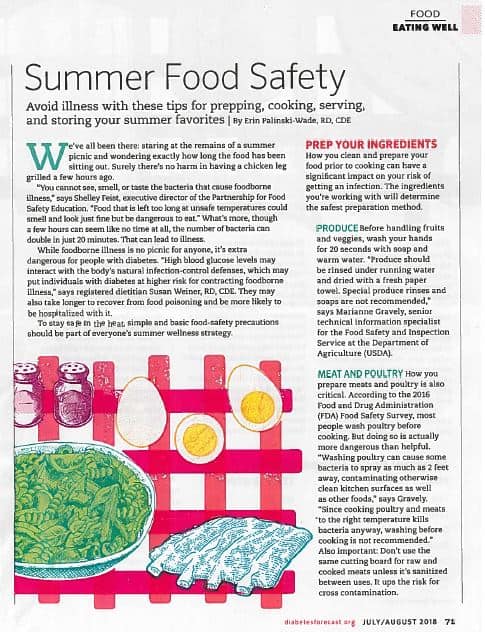 Shelley Feist, executive director of the Partnership for Food Safety Education, is featured in the July/August 2018 issue of Diabetes Forecast magazine. She discusses summer food safety and how to avoid foodborne illness when prepping, cooking, serving and storing your summer favorites. Read an excerpt from the article below.
Shelley Feist, executive director of the Partnership for Food Safety Education, is featured in the July/August 2018 issue of Diabetes Forecast magazine. She discusses summer food safety and how to avoid foodborne illness when prepping, cooking, serving and storing your summer favorites. Read an excerpt from the article below.
We’ve all been there: staring at the remains of a summer picnic and wondering exactly how long the food has been sitting out. Surely there’s no harm in having a chicken leg grilled a few hours ago.
“You cannot see, smell, or taste the bacteria that cause foodborne illness,” says Shelley Feist, executive director of the Partnership for Food Safety Education. “Food that is left too long at unsafe temperatures could smell and look just fine but be dangerous to eat.” What’s more, though a few hours can seem like no time at all, the number of bacteria can double in just 20 minutes. That can lead to illness.
While foodborne illness is no picnic for anyone, it’s extra dangerous for people with diabetes. “High blood glucose levels may interact with the body’s natural infection-control defenses, which may put individuals with diabetes at higher risk for contracting foodborne illness,” says registered dietitian Susan Weiner, RD, CDE. They may also take longer to recover from food poisoning and be more likely to be hospitalized with it.
To stay safe in the heat, simple and basic food-safety precautions should be part of everyone’s summer wellness strategy.
Thaw out
If you’re starting with frozen meat, take the proper precautions. “You should never defrost food at room temperature,” says Feist. “Food must always be kept at the safe temperature of 40 degrees or less during thawing.”
The safest place to thaw food without increasing the risk of bacterial growth is in the refrigerator. “Always make sure that meat and poultry thawing in the refrigerator do not leak juices onto other foods,” says Feist. That could lead to cross contamination.
Be a safe server
To avoid food spoilage and illness, perishable food should not be left out at room temperature for longer than two hours. “On very hot days, when the temperature exceeds 90 degrees, food should not be left out for more than one hour,” says Feist.
Store with care
Planning for leftovers? They’re often a source of foodborne illness, but some simple techniques can help keep your food safe long after the party ends.
When it comes to food safety, the faster you store your food, the better. “Cold temperatures slow the growth of harmful bacteria,” says Feist. Keep your refrigerator between 32 and 40 degrees and your freezer at 0 degrees or below. An appliance thermometer can help ensure the temperature is consistently at recommended levels.
When packing away leftovers, take care not to overcrowd your refrigerator or freezer. “Cold air must circulate to help keep food safe, and overcrowding can prevent this,” says Feist.
Read the full article in the July/August 2018 issue of Diabetes Forecast magazine.